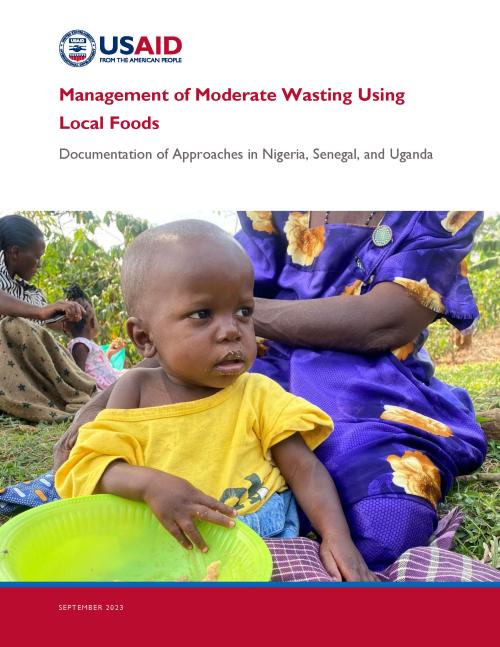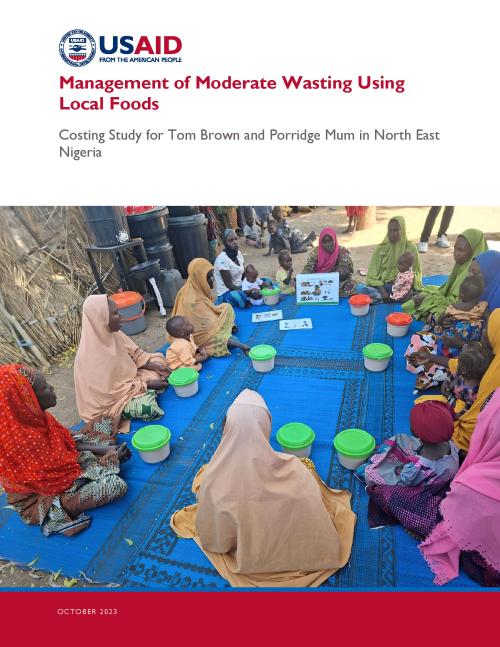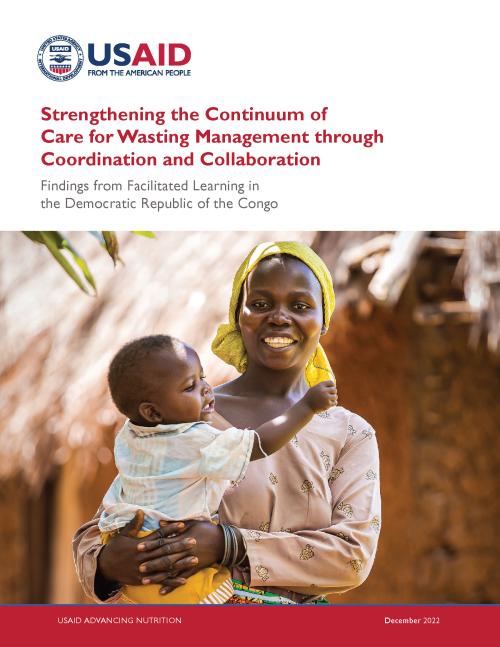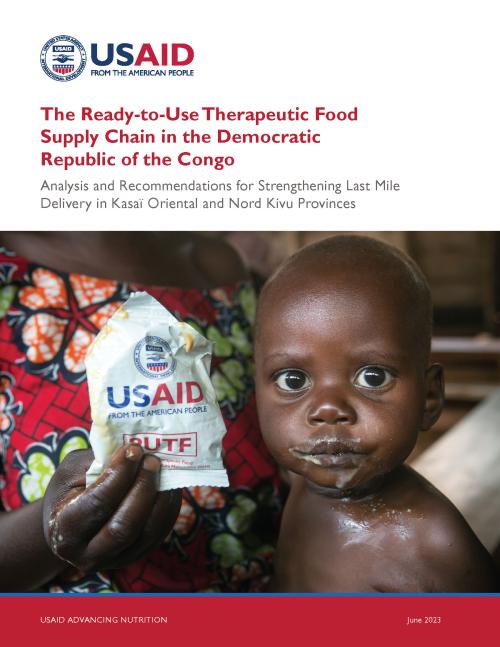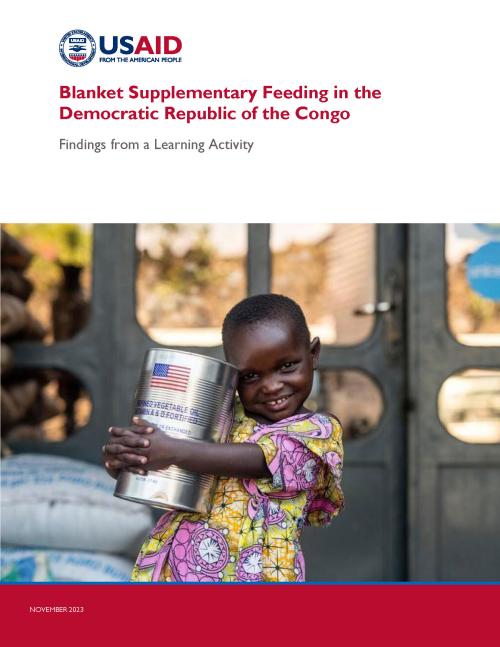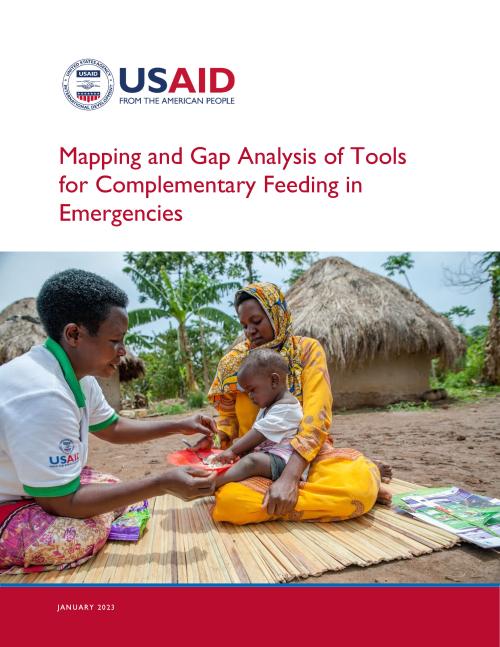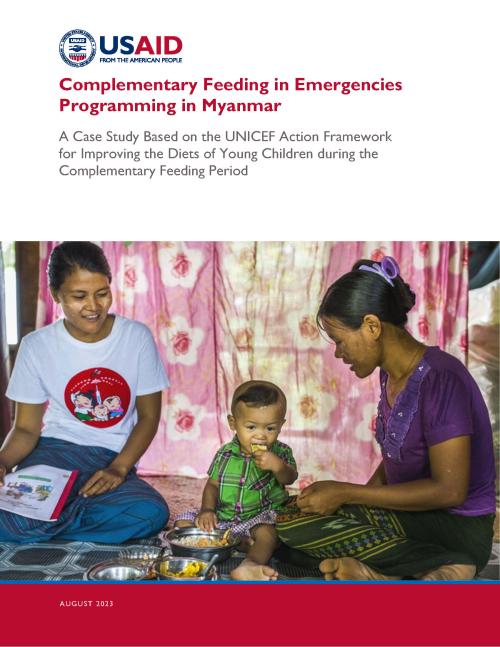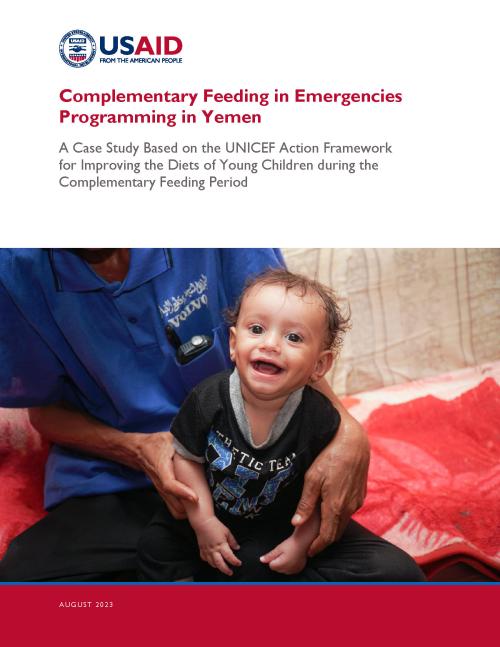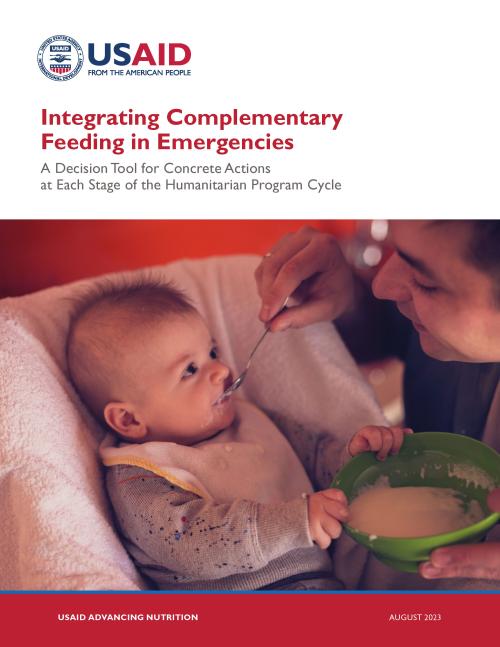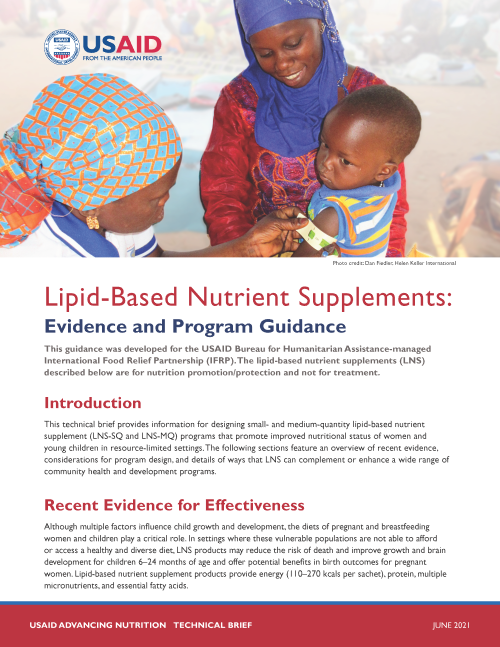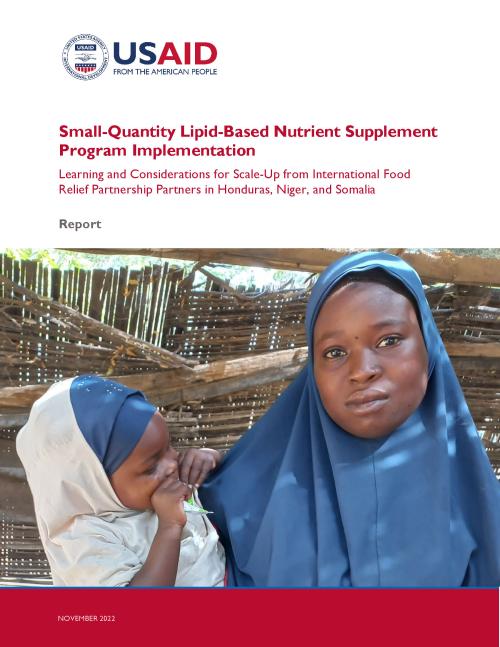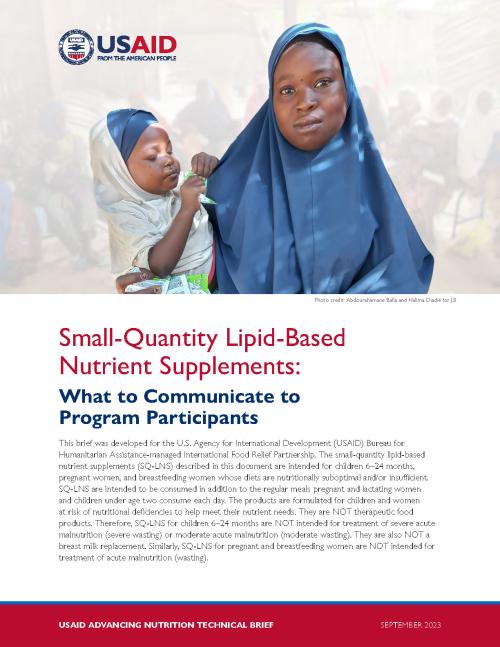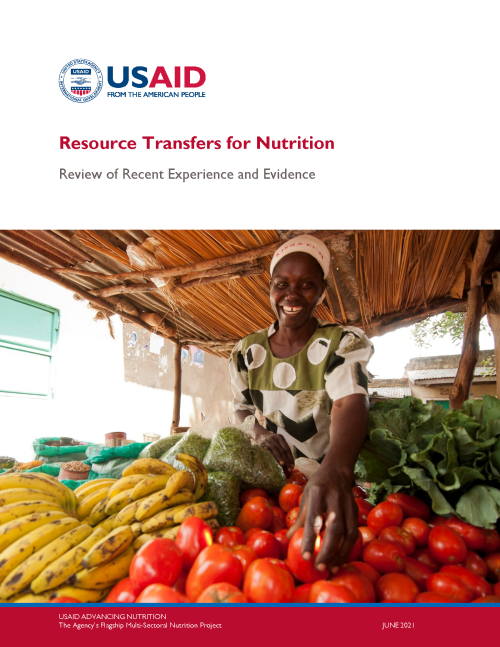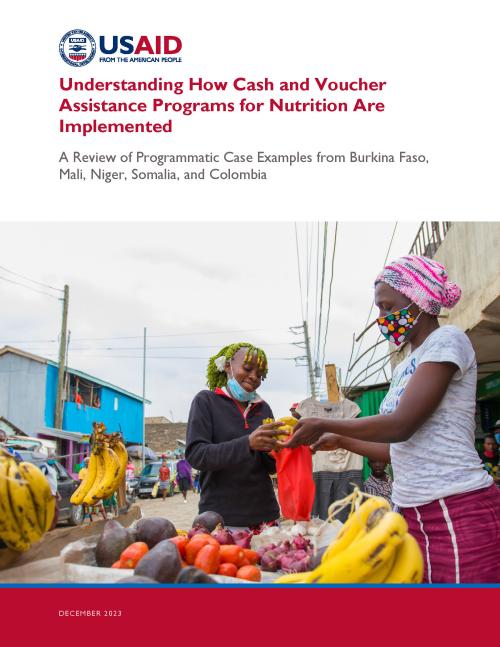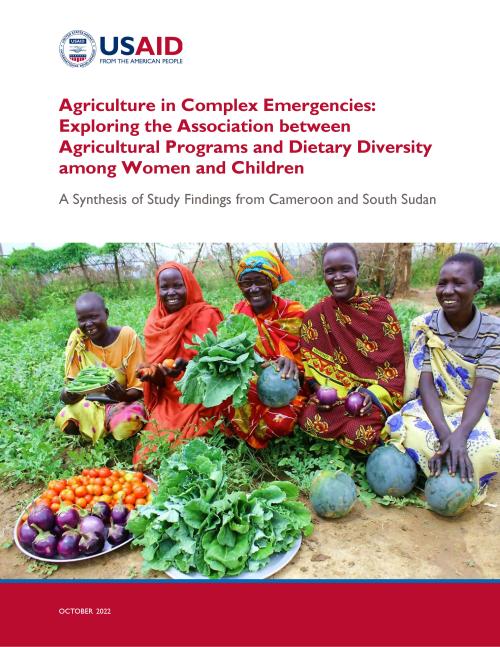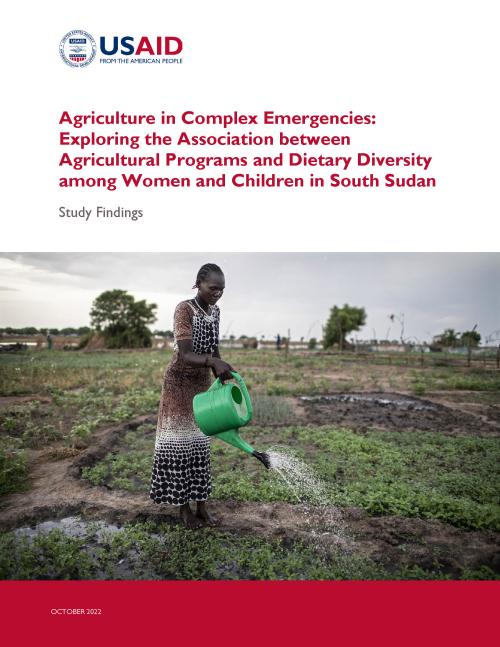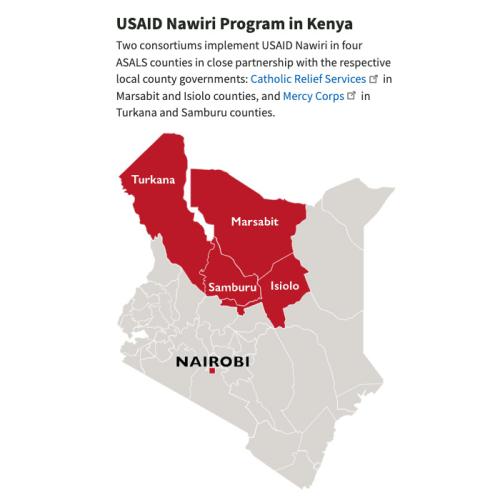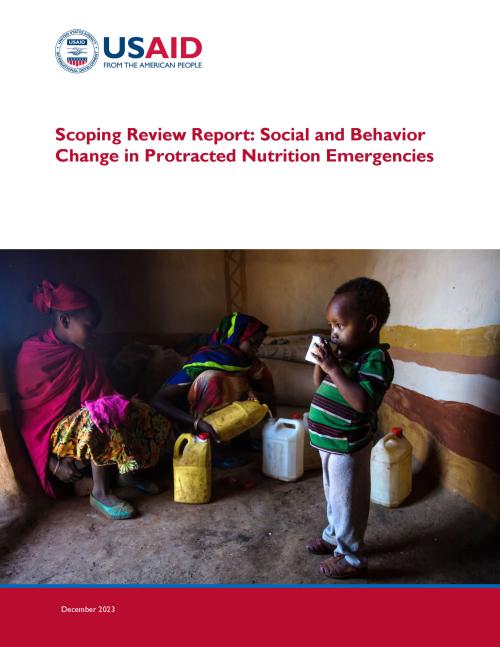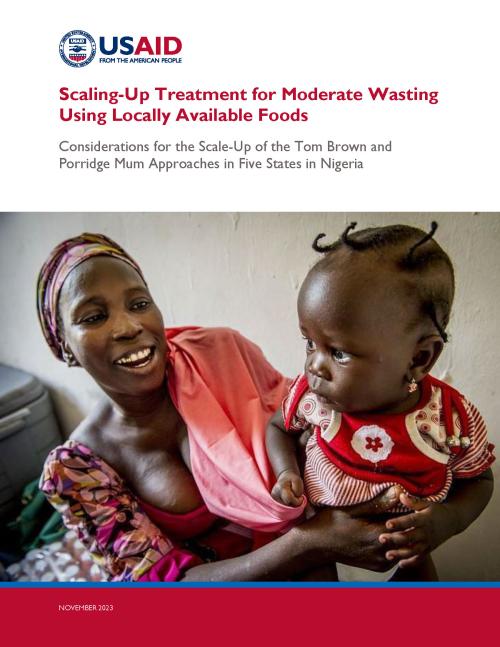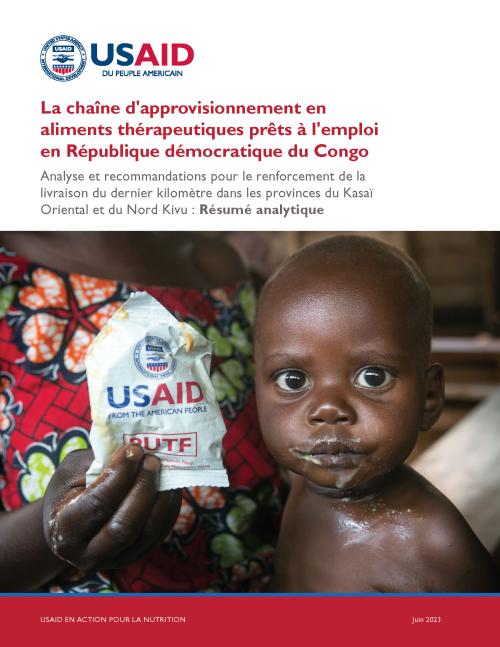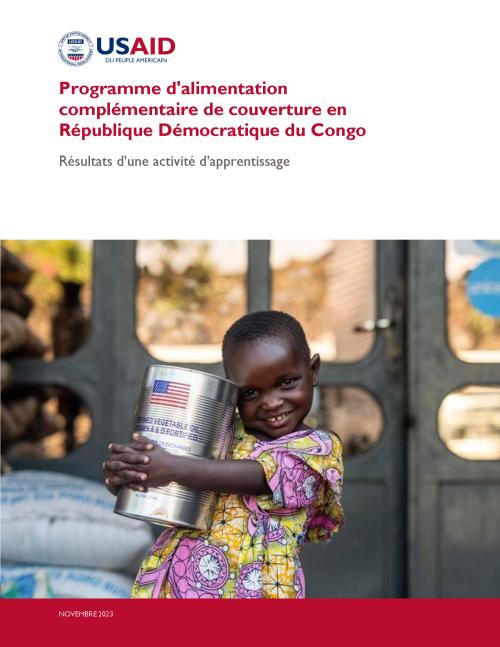
This resource collection aims to help program managers design and implement more holistic and integrated emergency nutrition programming by improving understanding of a variety of mechanisms including cash and voucher assistance, targeted lipid-based nutrient supplementation, agriculture, social and behavior change, complementary feeding, and wasting management. Use the search or filters below to find resources relevant to your work.
For resources developed to assist USAID Resilience and Food Security Activities, visit this collection.
We found 23 resource(s)
Management of Moderate Wasting Using Local Foods Documentation of Approaches in Nigeria, Senegal, and Uganda
This report presents the findings from a series of case studies conducted in Nigeria, Senegal, and Uganda. The findings from this report are very timely and have generated a high degree of interest from technical experts on wasting management, given the recent release of WHO's new guidance on the prevention and treatment of wasting in infants and children under five and the emphasis this guidance places on the use of local foods for moderate wasting management.
Management of Moderate Wasting Using Local Foods: Costing Study for Tom Brown and Porridge Mum in North East Nigeria
Nigeria’s use of alternative approaches using locally available foods to manage moderate wasting offered an opportunity to conduct a costing study to inform future programming and possible scale-up of these approaches, where relevant. Two approaches to moderate wasting management—Tom Brown and Porridge Mum—are the focus of this costing study
Strengthening the Continuum of Care for Wasting Management through Coordination and Collaboration: Findings from Facilitated Learning in the Democratic Republic of the Congo
The U.S. Agency for International Development Bureau for Humanitarian Assistance and the USAID Mission in the Democratic Republic of the Congo (DRC) asked USAID Advancing Nutrition to undertake a facilitated learning activity on purposeful co-location of nutrition partners in four provinces in the DRC. The executive summary of the final report on this activity summarizes findings related to three learning objectives: 1. Document partners’ experiences collaborating to deliver the continuum of care for wasting, 2. Identify and pilot actions to strengthen coordination and collaboration, and 3. Develop recommendations for how to strengthen collaboration to deliver the continuum of care for wasting. The activity yielded a wealth of information about the role of coordination and collaboration in delivering a holistic continuum of care for wasted children.
The Ready-to-Use Therapeutic Food Supply Chain in the Democratic Republic of the Congo
In the Democratic Republic of the Congo (DRC), the large numbers of children with severe wasting have led to an increased demand for ready-to-use therapeutic food (RUTF), the product used to treat children in outpatient care (IPC 2022). As part of efforts to understand and document the last mile delivery of this lifesaving product to health facilities in the DRC, USAID Advancing Nutrition studied four U.S. Agency for International Development (USAID)-supported RUTF pipelines. Using a mixed-methods approach, we sought to answer key research questions related to pipeline structure and cost, stock availability, and key challenges. We found that all pipelines faced problems with stockouts and transportation. Key informants highlighted several important opportunities for strengthening the pipelines, such as assessing the national supply chain’s readiness to integrate RUTF, improving RUTF donor coordination, and expanding the role of the Nutrition Cluster in supply chain management.
Blanket Supplementary Feeding in the Democratic Republic of the Congo: Findings from a Learning Activity
This report describes a learning activity that reviewed how the World Food Programme has designed and implemented blanket supplementary feeding programs (BSFP) in the Democratic Republic of the Congo (DRC) over the last 3–5 years, including the identification of any global guidance used. The report also provides information to help determine appropriate circumstances for using BSFP in the DRC in the future. While this report focuses on the DRC, it is intended to offer broader learning and considerations about BSFP in similar settings.
Mapping and Gap Analysis of Tools for Complementary Feeding in Emergencies
Recognizing the importance of protecting, maintaining, and potentially improving the diets of children under the age of two, there has been an increased focus on supporting infant and young child feeding in emergency contexts in recent years. However, the focus of activities has typically been on promoting exclusive breastfeeding with relatively less emphasis on complementary feeding practices. This report aims to identify the tools that are available to support complementary feeding in emergencies and assess where there are gaps and additional resources needed.
Complementary Feeding in Emergencies Programming in Myanmar: A Case Study Based on the UNICEF Action Framework
The 2020 UNICEF report titled "Improving Young Children’s Diets during the Complementary Feeding Period" provides an Action Framework to improve the diets of children 6–23 months of age. This report is one of four case studies that use the Action Framework as a tool to examine the efforts in emergency contexts to support complementary feeding. Lessons from this case study provide examples, for both country-level practitioners and global-level decision makers, of program interventions and policies to support complementary feeding in emergencies.
Complementary Feeding in Emergencies Programming in Yemen: A Case Study Based on the UNICEF Action Framework
The 2020 UNICEF report titled "Improving Young Children’s Diets during the Complementary Feeding Period" provides an Action Framework to improve the diets of children 6–23 months of age. This report is one of four case studies that use the Action Framework as a tool to examine the efforts in emergency contexts to support complementary feeding. Lessons from this case study provide examples, for both country-level practitioners and global-level decision makers, of program interventions and policies to support complementary feeding in emergencies.
Integrating Complementary Feeding in Emergencies: A Decision Tool for Concrete Actions at Each Stage of the Humanitarian Program Cycle
This decision tool is intended for those involved in the design, planning, implementation, and monitoring of a nutrition humanitarian response before and during an emergency. It aims to guide technical advisors and managers working on a humanitarian response to design and incorporate complementary feeding actions, whether they are implemented by individual organizations and/or by joint multi-agency humanitarian responses, for children 6–23 months of age, regardless of their breastfeeding status, at each stage of the humanitarian program cycle.
Lipid-Based Nutrient Supplements: Evidence and Program Guidance
This brief provides information on how to design small- and medium-quantity lipid-based nutrient supplement (LNS-SQ and LNS-MQ) programs that promote improved nutritional status of women and young children in resource-limited settings. The document also overviews considerations for program design and how LNS can be incorporated to complement or enhance a range of community health and development programs.
Small-Quantity Lipid-Based Nutrient Supplement Program Implementation
This report describes a learning activity to 1) document the factors that promoted and/or hindered successful implementation of small-quantity lipid-based nutrient supplements (SQ-LNS) programs in highly food insecure contexts and 2) garner perspectives on considerations for scale-up. The activity found that partners implementing SQ-LNS programs in Honduras, Niger, and Somalia operated through different delivery strategies and in varying program contexts. Despite this, one universal theme common across the partners was their strong relationship and coordination with national and/or local partner nongovernmental organizations (NGOs).
Small-Quantity Lipid-Based Nutrient Supplements: What to Communicate to Program Participants
This brief was developed for the U.S. Agency for International Development (USAID) Bureau for Humanitarian Assistance-managed International Food Relief Partnership. It provides information that will help implementing partners develop communication materials to accompany distribution of small-quantity lipid-based nutrient supplements (SQ-LNS) for children 6–24 months of age and pregnant and breastfeeding women whose diets are nutritionally suboptimal and/or insufficient. SQ-LNS are intended to be consumed in addition to the regular meals pregnant and lactating women and children under age two consume each day.
Modality Decision Tool: Nutrition Addendum
The Modality Decision Tool (MDT) Nutrition Addendum aids implementing partners to apply a nutrition lens to the selection of appropriate food assistance modalities (cash, vouchers, or in-kind) for the nutritionally vulnerable. This addendum is primarily oriented to USAID/BHA's "supplemental nutrition sub-sector" under their emergency activity guidance, but will also be applicable to resilience food security activities that provide a resource transfer to nutritionally vulnerable populations.
Resource Transfers for Nutrition: Review of Recent Experience and Evidence
Bureau for Humanitarian Assistance implementing partners (IP) use U.S. Agency for International Development guidance, existing tools, and technical and programmatic considerations to make activity design decisions and select between cash, voucher, and in-kind modalities to support activities. USAID Advancing Nutrition explored the experience of IPs in selecting between these programming modalities and reviewed a selection of evidence from a variety of sources to derive insights of relevance to development, rapid-onset, and protracted emergency settings. Through a review of IP reports, better practice documentation, and academic reviews of evidence, a list of relevant findings and recommendations for program design was developed.
Understanding How Cash and Voucher Assistance Programs for Nutrition Are Implemented: A Review of Programmatic Case Examples from Burkina Faso, Mali, Niger, Somalia, and Colombia
The purpose of this review was to identify and document case examples of programs in different countries and contexts that use cash, vouchers, or in-kind food assistance with nutrition activities to understand why and how these programs are implemented, and identify innovations that may inform and support the Supplemental Nutrition Assistance subsector programming of USAID's Bureau for Humanitarian Assistance.
Agriculture in Complex Emergencies: Exploring the Association between Agricultural Programs and Dietary Diversity among Women and Children: A Synthesis of Study Findings from Cameroon and South Sudan
The United States Agency for International Development’s (USAID's) Bureau for Humanitarian Assistance (BHA) seeks to improve the impact of emergency-funded agricultural activities on nutritional status, especially that of women and young children. USAID Advancing Nutrition explored where nutrition-sensitive agriculture activities are appropriate in emergency contexts and how they can be designed to improve nutrition outcomes. To inform these recommendations, USAID Advancing Nutrition conducted research with two BHA-funded activities. One activity is the Emergency Livelihood Response Programme in South Sudan, which is implemented by the Food and Agriculture Organization of the United Nations. The other is the Emergency Response to Food Insecurity for Lake Chad Basin Crisis Affected Populations in the Far-North Region of Cameroon, which is implemented by Première Urgence Internationale. This research report synthesized the quantitative and qualitative findings for both countries and provides recommendations and considerations for BHA in relation to its guidance for programming and implementation of emergencies award, with a specific focus on agriculture and livelihood components for nutrition outcomes.
Agriculture in Complex Emergencies: Exploring the Association between Agricultural Programs and Dietary Diversity among Women and Children in South Sudan: Study Findings
The United States Agency for International Development’s (USAID's) Bureau for Humanitarian Assistance (BHA) seeks to improve the impact of emergency-funded agricultural activities on nutritional status, especially that of women and young children. USAID Advancing Nutrition explored where nutrition-sensitive agriculture activities are appropriate in emergency contexts and how they can be designed to improve nutrition outcomes. To inform these recommendations, USAID Advancing Nutrition conducted research with two BHA-funded activities. One activity is the Emergency Livelihood Response Programme in South Sudan, which is implemented by the Food and Agriculture Organization (FAO) of the United Nations. This research report describes the quantitative and qualitative findings for the South Sudan component of the work that was performed under this activity in collaboration with the FAO.
Agriculture in Complex Emergencies: Exploring the Association between Agricultural Programs and Dietary Diversity among Women and Children in Cameroon: Study Findings
The United States Agency for International Development’s (USAID's) Bureau for Humanitarian Assistance (BHA) seeks to improve the impact of emergency-funded agricultural activities on nutritional status, especially that of women and young children. USAID Advancing Nutrition explored where nutrition-sensitive agriculture activities are appropriate in emergency contexts and how they can be designed to improve nutrition outcomes. To inform these recommendations, USAID Advancing Nutrition conducted research with two BHA-funded activities. One activity is the Emergency Response to Food Insecurity for Lake Chad Basin Crisis Affected Populations in the Far-North Region of Cameroon, which is implemented by Première Urgence Internationale (PUI). This research report describes the quantitative and qualitative findings for the Cameroon component of the work that was performed under this activity in collaboration with PUI.
USAID Nawiri Framework (Resource Collection)
This framework was implemented in partnership with the Government of Kenya in Marsabit, Isiolo, Samburu, and Turkana Counties, the USAID Nawiri program is a five-year initiative funded by the USAID Bureau for Humanitarian Assistance (BHA) to sustainably reduce persistent acute malnutrition in Kenya’s arid and semi-arid lands (ASALs). USAID Nawiri aims to help resolve the underlying causes of acute malnutrition through this integrated, multi-sectoral resilience-strengthening program that leverages ongoing emergency and development activities.
Scoping Review: SBC in Protracted Nutrition Emergencies
USAID Advancing Nutrition conducted a scoping review of social and behavior change (SBC) for nutrition in protracted emergencies to help stakeholders in the Bureau for Humanitarian Assistance (BHA). We identified a range of guidance and standards; toolkits; evidence reviews, briefs, and case studies; and project-specific documents. Project specific documents demonstrated that some implementers are using SBC methods, approaches, and platforms that are similar to nutrition SBC work in recovery or development contexts. We also discovered indications that SBC in emergency contexts has similar programming weaknesses to SBC in development contexts. For example, one monitoring plan measured inputs and outputs but did not include intermediate outcomes such as reducing barriers to priority behaviors.
Scaling-Up Treatment for Moderate Wasting Using Locally Available Foods: Considerations for the Scale-Up of the Tom Brown and Porridge Mum Approaches in Five States in Nigeria
Technical report on the review of scale-up feasibility of Tom Brown and Porridge Mum approaches in USAID Advancing Nutrition's five states in Nigeria.
La chaîne d'approvisionnement en aliments thérapeutiques prêts à l'emploi en République démocratique du Congo: Résumé analytique
En République démocratique du Congo (RDC), le grand nombre d'enfants souffrant d'émaciation sévère a entraîné une augmentation de la demande d'aliments thérapeutiques prêts à l'emploi (ATPE), le produit utilisé pour traiter les enfants en soins ambulatoires. Dans le cadre des efforts visant à comprendre et à documenter la livraison du dernier kilomètre de ce produit salvateur aux établissements de santé en RDC, USAID en action pour la nutrition a étudié quatre filières d'ATPE soutenues par l'Agence des États-Unis pour le développement international (U.S. Agency for International Development). En utilisant une approche mixte, nous avons cherché à répondre aux principales questions de recherche liées à la structure et au coût des filières, à la disponibilité des stocks et aux principaux défis. Nous avons constaté que toutes les filières étaient confrontées à des problèmes de rupture de stock et de transport. Les informateurs clés ont mis en évidence plusieurs possibilités importantes de renforcement des filières.
Programme d'alimentation complémentaire de couverture en République Démocratique du Congo Résultats d'une activité d'apprentissage
Compte tenu des niveaux élevés d'insécurité alimentaire et d'émaciation chez les enfants en République démocratique du Congo (RDC), le Bureau d'assistance humanitaire de l'USAID et la Mission de l'USAID en RDC ont réalisé des investissements importants par l'intermédiaire du Programme alimentaire mondial dans des programmes d'alimentation complémentaire de couverture (BSFP) en RDC. Les distributions alimentaires, telles que le BSFP, sont des interventions courantes dans les contextes de conflit et d'insécurité alimentaire, mais il existe peu de preuves sur leur couverture et leur efficacité en tant que stratégie de prévention de l'émaciation. L'USAID en action pour la nutrition a conçu et mis en oeuvre une activité d'apprentissage pour aider à combler ce manque de preuves.



